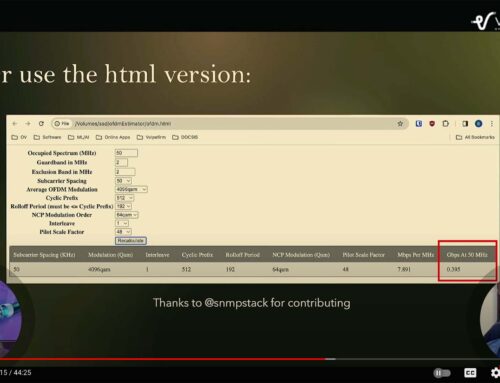Podcast: Play in new window | Download | Embed
Subscribe: Spotify | Email | RSS | More
In this episode Brady and John discuss what happens to an impaired DOCSIS Primary channel & ANGA COM highlights. When an impaired DOCSIS Primary channel occurs, do to one ore more impairment, how does it impact other DOCSIS channels? Primary being a type of “management” SC-QAM channel. Does it make a difference? We also cover the top content from the ANGA COM show. Didn’t have time to watch all of the ANGA COM show material. No problem. Brady and John will make sure your up to speed on the most important details from ANGA COM in this don’t miss episode. The discussion is on all things DOCSIS. Tips, suggestions and recommendations. Another power hour of cable with Brady Volpe and John Downey CMTS Technical Leader at Cisco.
The discussion is on all things DOCSIS. See a basic recap of Dynamic Range Window on our previous podcast or live stream.
Primary DOCSIS Channel “Downstream” Troubleshooting:
- Intro
-
(Bonded) Wondering if you could entertain a question I have about Primary DOCSIS QAM’s. We know that DOCSIS modems when connected to the CMTS, acquire one primary downstream QAM and one primary upstream QAM. Primary being some type of “management” QAM. The QAM that manages the traffic between the modem and the CMTS. If we believe that to be true, then here is my next question / train of thought….Let’s use these modems as examples:
DOCSIS 3.1 Modem Primary FWD QAM Primary RET QAM Modem A 597Mhz 21Mhz Modem B 591Mhz 21Mhz Modem C 591Mhz 25Mhz Modem D 603Mhz 32Mhz Modem E 597Mhz 38Mhz Modem F 609Mhz 21Mhz 
- Two channels can go off line but the modem will still be online. Unless there is a high speed tier.
- CMTS, T3 & T4 timeouts
- Impairments discussed
- QPSK
- High modulation
- Uncorrectable FEC
- Ping DOCSIS
- There is no Primary Upstream
- If there was a significant amount of upstream noise at 21Mhz…
-
- Would only Modem’s A, B and F experience packet loss?
- Would Modem’s A, B and F go offline?
-
- Alternatively, if there was a massive suck out, let’s say at 591Mhz. Severe enough that it puts that QAM well below -20db….
-
-
- Would only Modem’s B and C experience any packet loss?
- Would Modem’s A and B go offline?
-
-

- There’s a fault on the distribution somewhere that feeds the Tap which Modem D and F. The fault is such in a way that there is ingress specifically at 609Mhz. So much ingress that it essentially obliterates the QAM.
- Are both Modem’s D and F affected?
- What affect does this have on either modem? (IE, flapping, packet loss, etc)
- If the QAM is compromised, is the modem smart enough to switch to another primary frequency? Or does it need a reboot?




- Let’s say there is “upstream rolloff” down a crazy cascade of trunks to where the US/SNR at 38Mhz is below spec (17db or lower). Not due to a fault, but just sheer natural plant design.
- If Modem E is at a Tap at the end of said slew of trunk cascades, is there any impact to this modem? Even with the other 3 frequencies in tact.
- Where I’m going with this is, if a primary QAM (downstream or upstream) is impaired, does this affect the overall performance of the modem?
- ANGACOM 2021 Review
- Presentation overview of CISCO, Teleste, Harmonic, Intel, CommScope etc
- Topics reviewed:
- Fixed Mobile Convergence – FMC
- 5G
- Edge Compute
- DOCSIS 4.0
- MACPHY
- FMA – Flexible Mac Architecture
- R-PHY
- 10G
- DOCSIS
- IP
- Virtualization and Cloudification
- Nelsons Law is now broken – Agree or Disagree
- The human ear can only consume so much
- Cisco is working on a virtual CMTS
- No more CLI
- Topics reviewed:
- ANGACOM Presentations were very good!
End Podcast
John thank you for your time today. This was a great episode. Our next Episode 75 in May 21th
You can watch us live or recorded on Youtube or listen to us on your favorite podcaster. Links to everything is on the volpefirm.com webpage.
If you have enjoyed this webcast, please do hit the subscribe button so that you never miss an episode.
Thank you so much for being here and we will see you next month.
Upcoming events can be seen under Broadband Events. Previous events can be seen under the blog.
- If you are watching this on youtube please hit the subscribe button!
- Let us know what you think and remember to share!
- You can find slides at the bottom of the page and some on slideshare.
- Find out about events or articles by following us on Twitter, LinkedIn or Facebook too.
Also available on iTunes, Google Podcasts, Spotify, vurbl see podcasts “get your tech on”.
[pdf-embedder url=”https://volpefirm.com/wp-content/uploads/2021/04/DRW-Podcast.pdf” title=”Dynamic Range Window Podcast”]




Leave a Reply